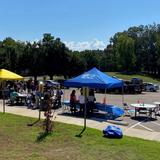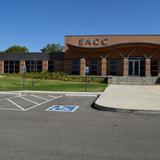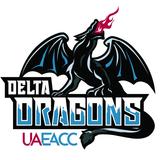- As an open-door, two-year institution of higher education, University of Arkansas-East Arkansas Community College's primary focus is a commitment to learning by educating and preparing students to become responsible citizens and contributing members of society.
School Highlights
University of Arkansas-East Arkansas Community College serves 1,789 students (32% of students are full-time).
The college's student-teacher ratio of 11:1 is lower than the state community college average of 13:1.
Minority enrollment is 50% of the student body (majority Black), which is more than the state average of 39%.
Quick Facts (2025-26)
- Enrollment: 1,789 students
- In-state tuition: $2,880
- Out-state tuition: $3,390
- Student-teacher ratio: 11:1
- Minority enrollment: 50%
- Source: Verified school update
Top Rankings
University of Arkansas-East Arkansas Community College ranks among the top 20% of public schools in Arkansas for:
Category
Attribute
Affordability
Debt For Students
School Overview
The teacher population of 165 teachers has stayed relatively flat over five years.
University of Arkansas-East Arkansas Community College
(AR) Community College Avg.
Carnegie Classification
Associate's Colleges: Mixed Transfer/Career & Technical-Mixed Traditional/Nontraditional
Associate's Colleges: High Transfer-Mixed Traditional/Nontraditional
Institution Level
Less than 2 yrs
At least 2 but less than 4 years
Institution Control
Public
Public
Total Faculty
165 staff
165 staff
School Calendar
Student Body
The student population of University of Arkansas-East Arkansas Community College has grown by 32% over five years.
The student-teacher ratio of 11:1 has increased from 6:1 over five years.
The University of Arkansas-East Arkansas Community College diversity score of 0.55 is less than the state average of 0.58. The school's diversity has stayed relatively flat over five years.
Total Enrollment
1,789 students
1,653 students
Student-Teacher Ratio
11:1
13:1
# Full-Time Students
575 students
595 students
# Part-Time Students
1,214 students
1,058 students
# Enrollment Undergraduate
178 students
194 students
# Full-Time Undergraduate Students
575 students
595 students
# Full-Time Graduate Students
n/a
15 students
# Part-Time Undergraduate Students
1,214 students
1,055 students
# Part-Time Graduate Students
n/a
38 students
Total Dormitory Capacity
n/a
160 students
% American Indian/Alaskan
1%
1%
% Asian
1%
2%
% Hispanic
1%
11%
% Black
43%
18%
% White
50%
61%
% Hawaiian
1%
1%
% Two or more races
3%
4%
% Non Resident races
n/a
1%
% Unknown races
n/a
1%
Diversity Score
0.55
0.58
College Completion Rate (Students who graduate in less than 4 years)
41%
36%
College Completion Rate (Students who graduate in 4 years or more than 4 years)
n/a
31%
Average Graduate Earnings (10 Years)
$24,800
$28,600
Tuition and Acceptance Rate
The public in-state tuition of $2,880 is less than the state average of $2,994. The in-state tuition has declined by 10% over four years.
The public out-state tuition of $3,390 is less than the state average of $4,750. The out-state tuition has declined by 10% over four years.
In-State Tuition Fees
$2,880
$2,994
Out-State Tuition Fees
$3,390
$4,750
% Students Receiving Some Financial Aid
94%
94%
Median Debt for Graduates
$5,250
$9,596
Median Debt for Dropouts
$3,000
$5,300
Acceptance Rate
n/a
100%
SAT Reading
n/a
540
SAT Math
n/a
520
SAT Writing
n/a
515
ACT Composite
n/a
22
ACT English
n/a
22
ACT Math
n/a
21
Sports
Total Sports Offered
1 sport
Sports
Intramural Sports Only
Extracurriculars
Total ExtracurricularsTotal Extra-curric.
1 extracurricular
ExtracurricularsExtra-curric.
Recreational Athletic Programs:
E-Sports
Source: 2024 (or latest year available) Integrated Postsecondary Education Data System (IPEDS) , School Administrators
School Notes
- School Mascot: Delta Dragons
- The College is dedicated to promoting the intellectual and cultural advancement of the community and to fostering tolerance and mutual respect among its members by offering the human and physical resources of the College. Through these efforts and through its cooperation with other educational institutions, the College is an active partner in the economic and social progress of Eastern Arkansas. Our primary focus is providing students with information and tools to help them make good choices. Academic advisors work closely with students throughout their college stay to establish trust and cultivate long-term advisor-advisee relationships. Students can expect to receive advising that encompasses exploration of life goals; exploration of vocational goals; program and course choices; and scheduling courses. The Learning Resource Center opened in December of 2000. The 15,000 square foot building houses the EACC Library, the Business and Industry Training Center, Continuing and Community Education, Tech Prep, the Distance Learning Lab, the Multimedia Lab, two conference rooms, and two classrooms. EACC offers many opportunities for students to participate in music courses and activities.
Profile last updated:
Frequently Asked Questions
How much does University of Arkansas-East Arkansas Community College cost?
University of Arkansas-East Arkansas Community College's tuition is approximately $2,880 for In-State students and $3,390 for Out-State students.
What sports does University of Arkansas-East Arkansas Community College offer?
University of Arkansas-East Arkansas Community College offers 1 interscholastic sports: Intramural Sports Only.
What is University of Arkansas-East Arkansas Community College's ranking?
University of Arkansas-East Arkansas Community College ranks among the top 20% of community college in Arkansas for: Least expensive tuition and Least debt for graduating students.
Recent Articles

How to Prepare for the January Semester at Community College
A complete guide to help community college students prepare for the January semester with checklists, planning tips, and academic strategies.

Hidden Costs of Community College ( 2025 update)
Understand the full cost of community college in 2025—tuition, books, living expenses, and hidden costs many families overlook.

Why Attend Community College (2025 Update)
Discover the renewed value of community colleges in 2025: affordability, growing enrollment, career pathways and flexible schooling for diverse learners.


































